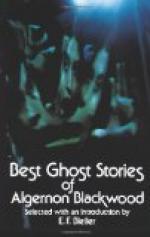One of the oldest and best-known Banshee stories is that related in the Memoirs of Lady Fanshaw.[F] In 1642 her husband, Sir Richard, and she chanced to visit a friend, the head of an Irish sept, who resided in his ancient baronial castle, surrounded with a moat. At midnight she was awakened by a ghastly and supernatural scream, and looking out of bed, beheld in the moonlight a female face and part of the form hovering at the window. The distance from the ground, as well as the circumstance of the moat, excluded the possibility that what she beheld was of this world. The face was that of a young and rather handsome woman, but pale, and the hair, which was reddish, was loose and disheveled. The dress, which Lady Fanshaw’s terror did not prevent her remarking accurately, was that of the ancient Irish. This apparition continued to exhibit itself for some time, and then vanished with two shrieks similar to that which had first excited Lady Fanshaw’s attention. In the morning, with infinite terror, she communicated to her host what she had witnessed, and found him prepared not only to credit, but to account for the superstition. “A near relation of my family,” said he; “expired last night in this castle. We disguised our certain expectation of the event from you, lest it should throw a cloud over the cheerful reception which was your due. Now, before such an event happens in this family or castle, the female specter whom you have seen is always visible. She is believed to be the spirit of a woman of inferior rank, whom one of my ancestors degraded himself by marrying, and whom afterwards, to expiate the dishonor done to his family, he caused to be drowned in the moat.” In strictness this woman could hardly be termed a Banshee. The motive for the haunting is akin to that in the tale of the Scotch “Drummer of Cortachy,” where the spirit of the murdered man haunts the family out of revenge, and appears before a death.
Mr. T.J. Westropp, M.A., has furnished the following story: “My maternal grandmother heard the following tradition from her mother, one of the Miss Ross-Lewins, who witnessed the occurrence. Their father, Mr. Harrison Ross-Lewin, was away in Dublin on law business, and in his absence the young people went off to spend the evening with a friend who lived some miles away. The night was fine and lightsome as they were returning, save at one point where the road ran between trees or high hedges not far to the west of the old church of Kilchrist. The latter, like many similar ruins, was a simple oblong building, with long side-walls and high gables, and at that time it and its graveyard were unenclosed, and lay in the open fields. As the party passed down the long dark lane they suddenly heard in the distance loud keening and clapping of hands, as the country-people were accustomed to do when lamenting the dead. The Ross-Lewins hurried on, and came in sight of the church, on the side wall of which a little gray-haired




